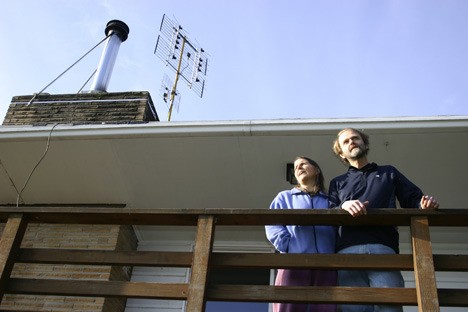The transition to digital television hasn’t been kind to some Islanders.
A handful of Vashon residents are unable to watch some or all network TV channels without paying for cable or satellite television. They’re not happy about losing the free service that most residents take for granted — some have invested in expensive antennas, while others have tried unsuccessfully to get cable wired to their woodsy property. All have had to settle for sub-par television reception, and there’s no solution in sight for them.
“There’s this small sample of a wide geographic on the Island who can’t get free TV anymore,” said Amy Wolff, an Islander who now lacks service. “So many of us have cable, but for those of us who would like not to, it would be nice to know what’s going on.”
The Gustafsons, who live in Burton, are one such family. They’ve strived mightily to receive network television channels without connecting to the local cable company.
“We’ve been getting progressively larger antennas until we have this enormous thing strapped on the roof,” said Barbara Gustafson. “Depending on atmospheric conditions, sometimes we get some stations and sometimes we don’t.”
Gustafson hasn’t coughed up the money for cable because she’s not interested in paying for channels she doesn’t intend to watch.
“I’m determined not to get cable, because I don’t want to pay the cable company for something that used to be free,” added her husband Richard Gustafson.
Richard said their family receives some foreign language channels and PBS, but only half as many network channels as they received before the transition this summer from analog to digital TV. And the reception they do have is quite temperamental, he added.
“A flock of geese will fly by and everything will go all pixelated,” he said. The transition to digital “is not an improvement,” said Richard, who estimates he’s spent $250 on aerial antennas.
Kathy Bonner lives on Cedarhurst Road, in an area that not only receives no network TV signals, but also isn’t wired for cable television. While most Vashon residences can have Comcast cable set up, there are some areas that are too far from cable poles to be easily hooked up, according to a Comcast customer support representative.
“I didn’t miss it for the first six months, but now that it’s winter, I wish we had TV,” Bonner said. “My husband and I used to watch the news every night, so we miss that.”
Gustafson, Bonner and other Islanders without network TV reception live in difficult-to-reach locations — with a hill or large stand of trees between their house and Seattle, where network television stations broadcast from.
“For lack of a better phrase, our area is terrain challenged,” said Willie McClarron, manager of broadcast operations for KING-TV and KONG-TV.
It’s common, he said, for there to be dead zones where residents are unable to pick up a digital signal.
“Instead of getting a little snow when reception isn’t that great, with a digital signal, you get nothing,” McClarron said. “We have this all over the region. People, especially on the south and west side of the Island, may not get good reception because they don’t have a line of sight to Queen Ann Hill.”
Leon Ringhouse, an engineer at KIRO-TV, estimated he’s received more than 100 calls from people wondering why their TVs, wired for digital reception, are unable to pick up local network stations.
The analog signal, he said, was lower frequency than the digital signal; the analog signal could “go over hills and bend back down.” When the higher-frequency digital signal comes in contact with an obstacle like a hill, it’s sometimes cut off from the regions on the other side of the hill.
“It depends on how far down below a hill you are,” Ringhouse said. “You might be able to use a better antenna, and try to get it as far in the air as you can get it.”
Someday, technology will become advanced enough that “dead zones” should be a thing of the past, McClarron said. But that day isn’t yet on the near horizon.
“Is it going to change? I think so,” he said. “Eventually there will be receivers that will be better able to use even part of the signal and get a picture. There’s a need for that. I expect that to happen, but I can’t say when.”



